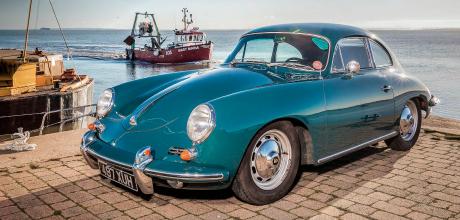1961 Porsche 356B T5 Coupe
Tantamount to the apocryphal barn find, Bob Knight lucked into an unblemished 356 B stashed away since 1973. Replete with a few carefully considered upgrades, the car is now on sale at air-cooled Porsche specialist, Karmann Konnection...
Words Johnny Tipler
Photography Paul Knight
KNIGHTS OF THE ROAD356 B PROJECT
A father and son’s 356 B project.
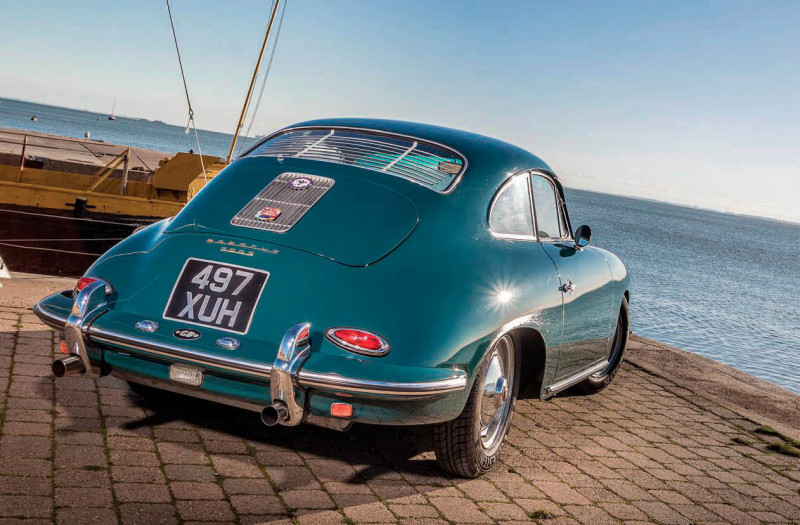
There’s a pleasing symmetry about synergy over a car shared between father and son. Even when it’s a possibility, there’s a multitude of reasons (one man’s meat, lack of funds, motivation, possessiveness or whatever) why such a collaboration might not work. Happily, in this case, we’re looking at a 356 B amounting to a joint venture between Bob Knight and his boy, Paul. Knight the Elder was running a car body repair shop in Basildon, Essex, when he purchased this four-cylinder Porsche. At the same time, Paul was serving — as he still does — as editor of popular Volkswagen magazines. Both men, then, were admirably qualified to contemplate the ‘barn find’ and elect what to do for the best.
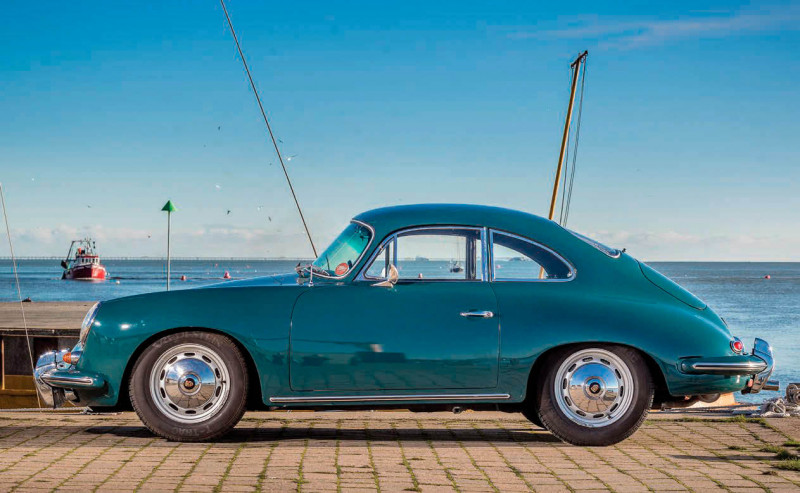
They deemed to perform full restoration on a car not in need of such drastic work would be tantamount to sacrilege. In contrast, judicious cleaning and measured fettling would do the Porsche justice as a ‘survivor’. According to Paul, Luke Theochari of Terry’s Beetle Services in Hanwell, West London, had kept the car in storage for many years. “I used to visit regularly, picking up parts for my many VW projects,” says Knight Jr. “One day, Luke told me about an old Porsche he kept in a former dairy building. Intrigued, I asked him to show me the car. And there it was!”
A COMPANY SUPPLYING DISC BRAKE CONVERSIONS FOR AIRCOOLED VOLKSWAGEN AND PORSCHE CARS SINCE 1987

Paul was told the car had been imported from Canada in 1968 and was subsequently UK road registered on a 1969 G-plate. The then owner used the diminutive Stuttgart sports machine for three or four years before parking it in a safe space and heading away on business. The car was never used again. “It was absolutely filthy, totally dirty!” Paul laughs, recalling his encounter with the car in Hanwell. “It hadn’t been touched for about ten years, but I could tell it was a lovely thing, with only about forty-five thousand miles on the clock. I told Luke I was interested in buying it, but he said it wasn’t for sale.”
Two years later, contrary to what he’d been told previously, Paul received a call from Luke offering him the 356. “He contacted me out of the blue and told me the car was available for purchase. Unfortunately, I didn’t have sufficient funds, but I told my dad about the Porsche and he was keen to take it on, having my assurance it was a good example of a 356 in need of little more than recommissioning.’”
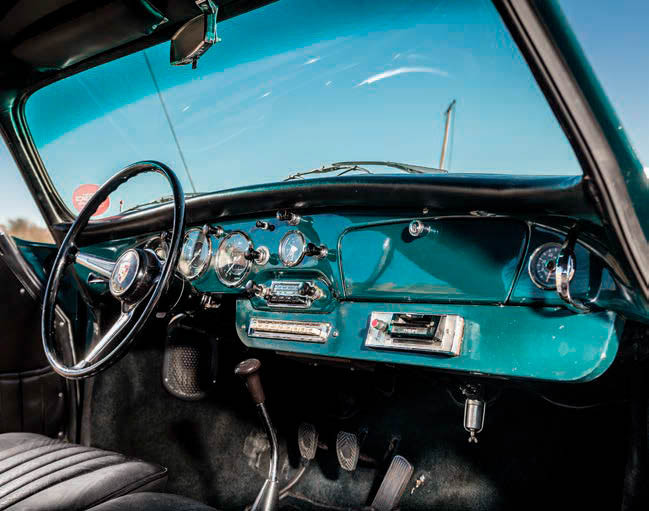
Bob ran Bob’s Paint and Bodywork in Basildon. It was here Paul had learned his mechanical skills, working alongside his dad, repairing and restoring mainly classic Volkswagens, plus the occasional Porsche. “I’d just equipped a Beetle with a 356 engine,” he recalls. “I suppose you could say we were on a bit of a Porsche roll — we’d not long built an Apal Speedster replica, which made use of genuine 356 parts. This project really got us excited about early Porsches, which is why dad was keen to get hold of an original 356 coupé.”
PAUL TOOK A CALL FROM THE RAYLEIGH GARAGE AND WAS INFORMED SOMEONE HAD MADE AN OFFER
Evidently, Luke had kept the car in good running order, starting it once a month and rolling it backwards and forwards to keep the mechanicals from seizing up. It wasn’t a going concern, though — the car required proper recommissioning. “It was running, but the brakes were non-existent, typical for an old Porsche left standing for so many years,” Paul recalls. “I wanted to leave its cosmetic condition as was, fix the mechanicals and drive it as we found it, but dad disagreed. He saw this 356 very much as a keeper and committed to stripping it down with the intention of a rebuild. I jumped on the mechanical side of things while he was dealing with the bodywork. We soon discovered there was a tonne of underseal to contend with. It had been applied very thick, presumably to ward off Canadian winters. We eventually removed three dustbin loads of the stuff!”
TAKE THE FLOOR
Bob and Paul employed a character known as Country Mike, whose job was to chip away every bit of underseal. When he’d finished, they could see the floorpan was in good shape. “The product had done its job. As you’d expect, the metalwork needed minor attention, but we were really only having to contend with a few previous repair patches in the wings, plus a couple on the floor. We didn’t buy any new panels, though. Country Mike fabricated what we needed and welded it in.”
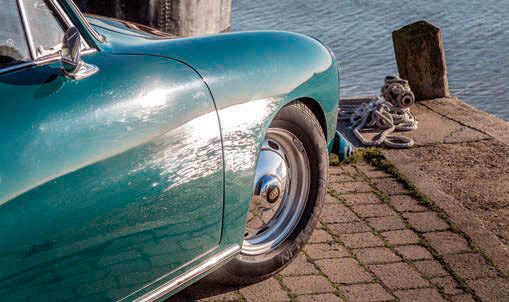
Overall, the car’s appearance was extremely good, with no corrosion, dents or crash damage to speak of, just a few little age-related marks to rectify. Indeed, Paul declared he wanted to go as far as he and his father could without subjecting the car to a full rebuild. “We’re into preservation and conservation, rather than restoration,” he tells us. With this in mind, the pair resolved to try and limit the exterior corrective work to a simple repaint.
ENGINE WAS HANDED TO PRILL PORSCHE CLASSICS FOR A FULLY DOCUMENTED REBUILD AND UPGRADED TO 1,720CC
Paul is proud of the job he did getting the Blaupunkt radio working. It’s a unit retro-fitted underneath the dashboard early on in the car’s life. There’s a cassette player, too. At first, Paul thought it was a vintage eight-track device, but he now reckons it is, in fact, an early example of the very first in-car cassette player released by Philips in 1967. In its day, this was a hot hi-fi.
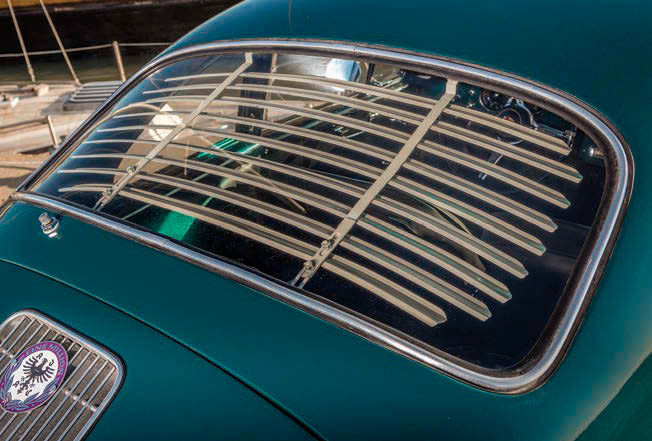
As far as the mechanicals were concerned, everything worked, though the clutch was slipping because the master cylinder was leaking. In the course of rectifying this complaint, Paul pulled the engine out. After a fierce debate about whether he should rebuild it, he decided to replace only the clutch, reasoning the flat-four was running reasonably well. “I used a Beetle 180mm heavy-duty clutch, costing just over £1,500. It worked really well, but then I had to replace the accelerator pump because it fell to pieces.” Logically, Paul also attended to the brakes. He was hoping to take advantage of a few spare drums stockpiled from various other projects. “I was planning to have them skimmed, but they weren’t in as good condition as I thought. Instead, a local engineering shop remanufactured the parts for me, but we still had trouble with the fronts — we broke a couple. The work was beginning to get expensive!”
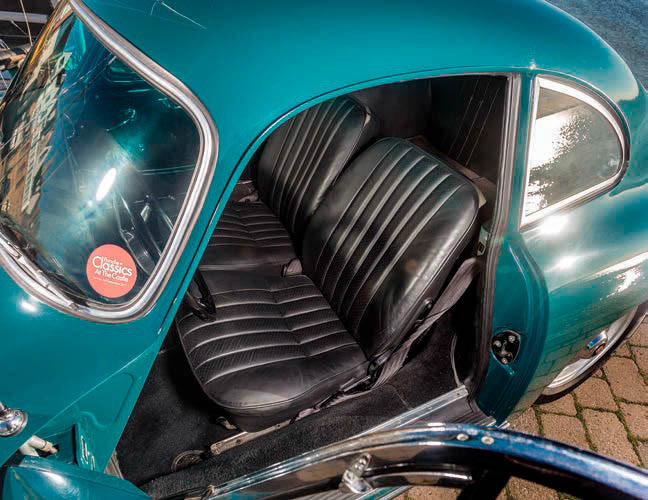
It was at this point a change of plan came into being: the 356 would be converted to run disc brakes. There’s nothing too radical about such a switch, not lease because the follow-on 356 C made use of discs as standard equipment. Even so, aficionados will tell you the drums on the late-model 356 B are perfectly adequate. Paul made the call to Custom & Speed Parts Autoteile (also known as CSP Shop), a company supplying disc brake conversions for air-cooled Volkswagen and Porsche cars since 1987. “The firm had just released a new disc brake kit,” Paul remembers. “It was brilliantly made. CSP supplied the whole conversion kit, as well as a new master cylinder. The cost was about £1,200, but the upgrade made such a positive difference. The brakes on this car are now nothing short of amazing.”
As far as the exterior is concerned, Bob painted the car in a lick of Fjord Green, replicating the original colour, which is a fairly unusual hue. The interior, meanwhile, was in a condition commensurate with a car that had covered so few miles, meaning it needed little more than a good clean.
The next significant step was lowering the front suspension. A visit to Karmann Konnection led to a run out in a 356 Carrera, the competition-focused version of the 356 line-up. Paul immediately decided the Fjord Green machine needed a nose as low as that of the racier Porsche. Now, the 356 already has adjustors in the front torsion bars. Paul noticed they are basically the same as those found on the Beetle, which he had vast experience of tweaking. “I decided to do for the 356 what I’d done to plenty of Beetles over the years,” he shrugs. “I took the front suspension apart, concentrating on the adjustor blocks, and sanded those down as low as I could get them. Height was then down about an inch. I wanted a bit more, though, which is why I grabbed my Dremel and extended the slots on each of the bars. Eventually, I was able to reduce ride height by around two-and-a-half inches.” The look was as he wanted it, but how had lowering just the front end affected ride and handling? No worries on that score. “It drove lovely thereafter. It handled exactly as I’d hoped. As for the looks, when you walk around the car, it simply looks more purposeful.”

Unusually, this 356 also features a mounting for a rear windscreen wiper. “When we got the car, we talked about getting rid of this feature, but obviously someone had thought to add it to original specification,” Paul confirms. “Ultimately, we fitted a new wiper.” It’s gone now, but could easily be recommissioned at Karmann Konnection, where the car is currently being offered for sale. “Oh, there’s one more thing I’d like to point out,” Paul urges. “The Venetian blind in the rear window is from an Australian-manufactured 1961 Beetle.”
That’s about as far as the mods go. Paul had the steel wheels sand-blasted and Bob repainted them to look as if they were standard originals. He also acquired fresh hubcaps, while Paul found a set of new-old-stock Pirelli XAF 165s. “I’m a bit of a tyre geek,” he confesses. “This is exactly what I was after, complete with the check tread pattern. You can really throw a 356 around on this rubber.”
This is pretty much how the car was when it ended its tenure with the Knights, by which time the clock had moved forward to 2008. Not long after, Bob closed his workshop, effectively retiring, while Paul focused on his journalistic and publishing activities. He is currently editor of Volksworld.
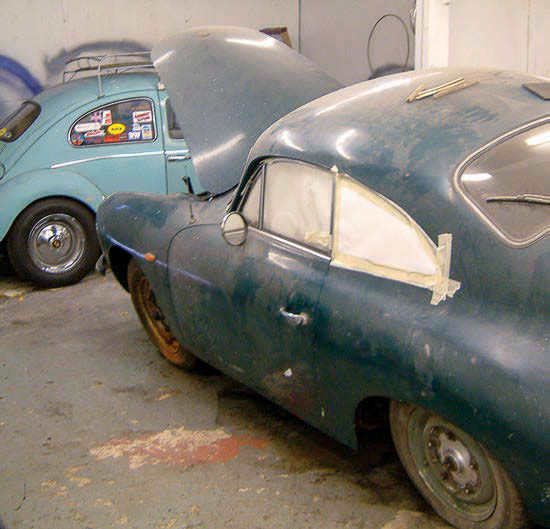
To get things in context, briefly, let’s talk about the evolution of the 356. Launched in 1948, the first Porsche was effectively a mid-engined 356 Speedster — the flat-four was located in front of the rear axle, per the later 550 Spyders and, much later, the Boxster family. The first 356 coupé was completed in July 1948, with rear-mounted 40bhp 1,131cc Volkswagen engine. Beware oversteer!
Bodies were made either in-house at the Porsche workshop in Gmünd or by Beutler and Reutter. Porsche relocated to Stuttgart- Zuffenhausen in 1949 and, later that year, ordered five hundred bodies from Reutter Karosserie, setting the seal on the majority of 356 body supply for the duration of the model.
Deliveries to customers began in April 1950, with sales totalling thirty-three cars per month. In 1951, engine capacity rose to 1,286cc, with a 1,488cc unit available later in the year. Stylistically, the major advance came in 1952 with the introduction of a one-piece windshield in place of the two-pane screen. Inside, there was a folding rear seat, the spare wheel positioned upright for better luggage stowage, and bigger drum brakes were fitted.
Significantly, the archetypal Porsche crest was also designed. By 1954, a host of model designations based on coupé, cabriolet and Speedster bodies were in play. The five-thousandth 356 rolled off the line in March 1954. The 356 A appeared in October 1955 for the 1956 model year, flagging up improvements to mechanicals, suspension, steering and instrumentation. The 1500 GS Carrera (as featured in last month’s issue of Classic Porsche) was the ultimate variant, though four other engine options were available. Myriad evolutions and upgrades were regularly introduced, such as vertical bumper guards, Zenith carburettors, a Haussermann diaphragm clutch and ZF steering box.
At the 1959 Frankfurt Show, the 356 B was unveiled for the 1960 model year. This new(ish) Porsche for a new decade featured raised bumpers front and rear — this was as radical a step as the bellowed impact bumpers imposed on the 911 in 1974. The 356’s headlights were raised to the top of the front wing-line, with protruding parking lights above the bumper. Air intake grilles for brake cooling were inset below.
The front lid’s leading edge was rounded off and the hubcaps now had raised centres. Cast aluminium brake drums had seventy-two radial fins and Alfin cast-iron liners. Larger oil pumps were installed in 1960, along with further improvements to engine componentry. There were opening vent wings in the side windows and, in the cabin, the rear seats were lowered, with split seat backs to provide more accommodation in the back. Three kids, anyone?
In 1961, Koni dampers were introduced, with slightly smaller rear torsion bars and a transverse leaf, known as a camber compensator, to reduce rear roll stiffness. Open-top bodies were built by Drauz (the Convertible D) and D’Ieteren (Roadster), with Karmann making the notchback coupé. In 1962, the 356 B received two grilles in its engine lid, and the coupé got a bigger rear window, plus a trapdoor for the fuel filler in the right-hand front wing. The fuel tank itself was now a flatter unit filling more of the floor (or the front compartment), while the battery was relocated to the right-hand side.
The two-litre Carrera model was released in September 1961 for the 1962 model year, and, in 1963, Porsche acquired Reutter and thus effectively brought body construction in-house, leaving the seat manufacturing side of the business as an independent company (Recaro). This move paved the way for the 356 C, launched in July 1963. The major innovation was disc brakes, supplied by Ate under licence from Dunlop. Minor modifications instituted annually contrived to improve drivability, handling, comfort and ease of maintenance, whilst at the same time, a host of subtle yet beneficial modifications were made to the 1600 (1,582cc) engines at the behest of Hans Mezger, Porsche’s engineering design wizard from 1956 to 1985. Production of the 356 C ended in September 1965, marking a total of 76,303 examples of the 356 during a fruitful fifteen-year run.
Going back to our feature car, then, a little more history is in order. During Bob Knight’s ownership, this gorgeous green 356 didn’t venture far. According to Paul, “to be honest, he was one of those guys for whom it was all about the build. He recommissioned, restored and modified cars, but never really drove them. I’m the opposite. Any car I own, I just want to drive the crap out of it, every chance I get. Dad drove the 356 to Norfolk a couple of times, but his hobby was fishing. He’d put his rods in the Porsche and drive over to the local fishing lake. I thought the car deserved better than being left in a muddy field while its owner went fishing! He had grand intentions of taking it to the Le Mans Classic, but he ended up attending the event with a friend in a Jaguar XK120. I’m sure the Porsche would have been more fun, but they probably had a bit more room in the Jag. It’s safe to say I did more miles in the Porsche than he ever did.”
Father and son were nothing if not prolific petrolheads. “At one point we had about twenty-seven cars between us, but the 356 was the only one he kept hold of,” Paul reminisces. “All the others went. He kept the Porsche for a few years, but by the time he retired, the only person using it was me. A friend of his owned a classic car sales garage in Rayleigh, Essex, and invited him to park the Porsche in the sales showroom, reasoning everybody loves a good 356 — visibility would equate to good publicity and, potentially, a higher rate of customer footfall. Incidentally, the same dealer sold the Apal Speedster we built. It went to a museum in Austria.” It was only a matter of time before a buyer emerged for the Fjord Green 356 B. Indeed, Paul took a call from the Rayleigh garage and was informed someone had made an offer. Bob conceded it was time for the car to head to pastures new.
FRIENDS REUNITED
Time passed, but somewhat inevitably, Porsche paths crossed — Paul saw his dad’s old 356 at a classic car sale in 2021. “I walked up and spoke to the owner. I told him I’d carried out a lot of work on the car. To my surprise, he didn’t know much of the history behind it, having bought the Porsche blind. It has stayed in Southend and the surrounding area, but has changed hands a few times over the years.”
Paul next saw this 356 up close when he came to take the photos you see on these pages. He captured them at Karmann Konnection, where the car is currently advertised for sale. “Since parting with this car all those years ago, I hadn’t seen it in detail until Classic Porsche editor, Dan Furr, asked me to photograph it for inclusion in the magazine. I was shocked to discover how, somewhere along the line, someone had re-covered the seats. This is a real shame because they were in tip-top condition and original to the car. That said, the team at Karmann Konnection advised me the seller didn’t like the black upholstery, hence commissioning a retrim in dark green. Truth be told, photographing the car was an emotional experience. Many memories came flooding back.”
This Porsche is currently waiting for its next owner at Karmann Konnection’s base in Prittlewell, Southend-on- Sea, doyenne of the Essex Riviera. Patron, Ritchie King, gives us the lowdown from his perspective. “The car has never been fully restored, meaning it possesses an honest feel. The paint is holding up well, tribute to the fact the body was subjected to another respray after a previous owner scratched one of the panels. There’s slight bubbling to the lower skin on the right-hand-side door and there are signs of age inside the car, but in November 2018, the engine, which is a non-matching numbers boxer from 1962, was handed to Prill Porsche Classics for a fully documented rebuild. While the work was carried out, the unit was upgraded to 1,720cc using 86mm pistons and liners.” That’s the bonus windfall in the story. Rest assured the invoice for this work is included in the car’s accompanying documentation.
As Paul Boosey at Karmann Konnection sums up, “this is a great 356 in a rare factory colour. It drives brilliantly and comes with optional rear wiper. Included in the sale is a very rare under-the-dash panel housing an additional Blaupunkt pre-set radio unit, plus a rare mid-1960s Phillips cassette player.” A real gem, then, adheres nicely to its original specification. Well, what are you waiting for?!
Above and facing page The Knights preferred preservation over restoration, resulting in a wonderfully original classic Porsche.
Above The car, imported from Canada in 1969, is currently at Karmann Konnection patiently awaiting its next owner.
Above Paul’s dad gave the car a full respray in Fjord Green, though a subsequent owner had the car painted again after accruing a number of nasty bodywork scratches. Below Venetian blind is from an Aussie-built 1961 Beetle.
Above Flat-four was fully rebuilt and oversized to 1.7 litres at Prill Porsche Classics.
Above and below Interior was retrimmed from original black to green leather, though the shade is so dark, it looks black in most lights. Above If ever a 356 could be described as ‘a family affair’, then this imported B is surely it, such is its rich history with the Knight clan.
Below How the car was when Paul first laid eyes on it.


